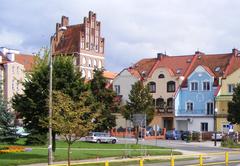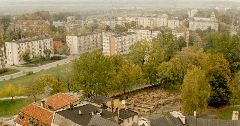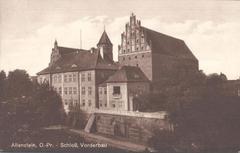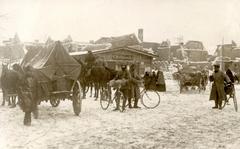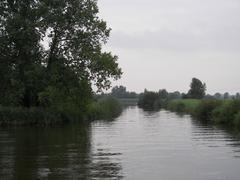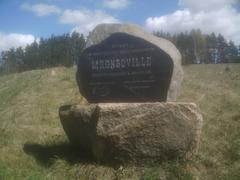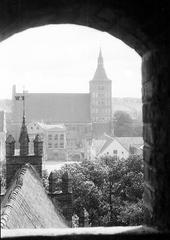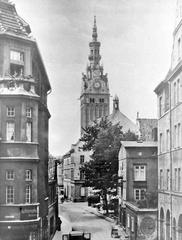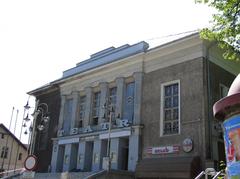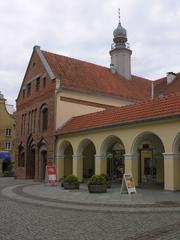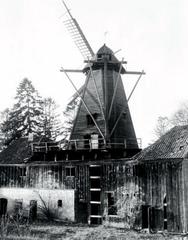Church of the Holy Spirit Elbląg: Visiting Hours, Tickets, and Historical Guide
Date: 04/07/2025
Introduction
The Church of the Holy Spirit (Kościół Świętego Ducha) in Elbląg, located in the Warmian-Masurian Voivodeship of northern Poland, is a remarkable symbol of the city’s medieval heritage and cultural resilience. Founded in the 13th century by the Teutonic Knights, this historic structure initially served as both a place of worship and a hospital, embodying the medieval Christian tradition of combining spiritual and charitable care. Over the centuries, the church has survived fires, wars, and political upheavals, and today, it stands restored as part of the Cyprian Norwid Elbląg Library. Its Gothic architecture, storied past, and adaptive reuse make it a must-visit for history enthusiasts, architecture lovers, and cultural travelers alike.
This comprehensive guide covers the church’s origins, architectural evolution, current visiting hours, ticket policies, accessibility, and its ongoing role in Elbląg’s cultural and community life. The article also highlights nearby attractions and provides practical tips to enhance your visit.
For official information and further planning, consult the Elbląg tourism office, the Cyprian Norwid Elbląg Library, and historical resources like Castles of Poland.
Historical Overview
Origins and Foundation
Elbląg was founded in 1237 by the Teutonic Knights, who played a pivotal role in the Christianization and urban development of the Baltic region (Castles of Poland). The Church of the Holy Spirit was established soon after as both a parish church and a hospital, situated near the Teutonic castle and at the heart of the city’s early civic and social structures.
Architectural Evolution
Medieval Beginnings
The church’s original construction dates to the mid-13th century, employing brick to create a resilient structure able to withstand the frequent fires that plagued medieval towns. Its dual function as a hospital and church was typical of the era, reflecting the integration of spiritual and social care.
Surviving the Great Fire and Rebuilding
A devastating fire in 1288 destroyed much of Elbląg, but the brick-built Church of the Holy Spirit endured, prompting a shift towards more fire-resistant architecture citywide. Over the next centuries, the church was expanded and adapted in the Gothic style, with pointed arches, ribbed vaults, and buttresses characteristic of the Baltic region (Castles of Poland).
Later Modifications
As Elbląg prospered, especially during its Hanseatic League period, the church likely underwent further enhancements, possibly incorporating Renaissance or Baroque elements (Rabbit Trans Poland). Over time, its hospital function was phased out, with the building increasingly dedicated to religious and community activities.
Modern Era and Preservation
World War II brought significant destruction to Elbląg, and like many of the city’s landmarks, the Church of the Holy Spirit suffered extensive damage. Restoration efforts began post-war, focusing on preserving the building’s Gothic character while adapting it for new uses. The church now houses the Cyprian Norwid Elbląg Library, blending historical preservation with contemporary community service (Cyprian Norwid Elbląg Library).
Architectural Features
Exterior and Structure
The Church of the Holy Spirit is a fine example of Brick Gothic architecture. Its exterior features pointed arches, ribbed vaults, and a steeply pitched roof, all designed to evoke a sense of verticality and spiritual aspiration (Mandry Club). The church tower, while less imposing than some neighboring cathedrals, remains a distinctive feature of the Elbląg skyline.
Interior Highlights
Inside, visitors can appreciate the spacious nave, illuminated by tall Gothic windows and supported by slender columns. While much original artwork was lost during wartime, restored altars, stained glass, and religious iconography maintain an atmosphere of reverence and history. The building’s acoustics also make it an excellent venue for concerts and cultural events (Sacred Architecture).
Transformation into the Cyprian Norwid Elbląg Library
After World War II, the Church of the Holy Spirit underwent a careful restoration and was repurposed as the Cyprian Norwid Elbląg Library (Cyprian Norwid Elbląg Library). The main hall now serves as a reading and event space, while adjoining historic hospital buildings accommodate additional library functions. The library’s collection includes rare books from the 16th to 18th centuries, making it an important center for research and cultural activities (Polskieszlaki.pl).
Visiting Information
Opening Hours
- Monday to Friday: 9:00 AM – 7:00 PM
- Saturday: 10:00 AM – 4:00 PM
- Sunday: Closed
Hours may vary during holidays or special events. Always check the official library website before your visit.
Tickets and Entry
- General entry: Free
- Special exhibitions/events: May require tickets; available on-site or via the library’s website
Accessibility
- Ramps and adapted facilities are available for visitors with mobility challenges
- Some historic features may limit full access; contact staff for specific needs
Guided Tours
- Guided tours covering the building’s history and architecture are available upon request. Advance booking is recommended.
Photography
- Allowed in public areas; restrictions may apply in reading rooms or during special events. Always ask staff for guidance.
What to See and Do
- Gothic Architecture: Explore original brickwork, vaulted ceilings, and preserved altars
- Rare Book Collections: Attend special exhibitions featuring volumes from the 16th–18th centuries
- Cultural Events: Enjoy lectures, concerts, and art exhibitions held in the atmospheric former church
- Heritage Trail: Follow Elbląg’s “Church Path” (Ścieżka Kościelna), a medieval alley marked by ten Gothic arches linking the city’s principal churches (Finding Poland)
Nearby Attractions
- St. Nicholas Cathedral
- Elbląg Old Town Market Square
- Elbląg Canal Museum
- Teutonic Castle ruins
- Market Gate
- EL Gallery Art Center
These sites provide a comprehensive experience of Elbląg’s layered history and cultural vitality (Wild Trips).
Cultural and Community Role
The Church of the Holy Spirit has long served as a center for both spiritual life and social welfare. In its current incarnation as a library and cultural venue, it continues to host religious festivals, educational events, and community gatherings, maintaining its legacy as a hub of local identity and resilience (Polskakultura.com).
Practical Travel Tips
- Best time to visit: April to September for festivals and good weather; winter offers a quieter experience
- Accommodations: Stay in Elbląg’s Old Town for convenient access to major attractions
- Dining: Enjoy traditional Polish cuisine at nearby restaurants
- Transport: Elbląg is easily reached from Gdańsk and other regional centers; public transit connects the Old Town
- Visitor etiquette: Dress modestly, respect ongoing services, and maintain quiet inside the church
Frequently Asked Questions (FAQ)
Q: What are the Church of the Holy Spirit’s visiting hours?
A: Monday to Friday: 9:00 AM – 7:00 PM, Saturday: 10:00 AM – 4:00 PM, closed on Sundays. Hours may vary on holidays.
Q: Is there an entry fee?
A: No, general entry is free. Special events may require tickets.
Q: Are guided tours available?
A: Yes, available on request; book in advance.
Q: Is the church accessible for visitors with disabilities?
A: Most public areas are accessible; contact staff for support in specific areas.
Q: Can I take photographs?
A: Yes, in public areas unless otherwise posted.
Preservation and Future Prospects
Ongoing conservation ensures that the Church of the Holy Spirit retains its historical features while serving modern community needs. Restoration campaigns in the 1990s and 2000s have set an example for adaptive reuse of sacred heritage in Poland (Medieval Heritage). The church-library continues to inspire similar projects nationwide.
Map and Visual Resources
View the Church of the Holy Spirit and Nearby Attractions on Google Maps
High-quality images and virtual tours are available through the Elbląg tourism portal, showcasing the Gothic façade, restored interiors, and rare manuscript collections.
Plan Your Visit and Stay Connected
Download the Audiala mobile app for offline guides, interactive maps, and audio tours of the Church of the Holy Spirit and other Elbląg attractions. Follow us on social media for updates about cultural events, heritage news, and travel inspiration.
Summary
The Church of the Holy Spirit in Elbląg is a living monument to the city’s medieval roots, endurance, and ongoing cultural vibrancy. From its foundation as a hospital church to its rebirth as a modern library, it offers visitors a unique blend of history, architecture, and community engagement. Whether you’re seeking a quiet place for reflection or a rich educational experience, this site is a highlight of Elbląg’s heritage trail.
For up-to-date hours, events, and visitor resources, refer to the Cyprian Norwid Elbląg Library official website and the city’s tourism office.
Sources and Further Reading
- Castles of Poland
- Mandry Club
- Cyprian Norwid Elbląg Library
- David’s Travel Guides
- Rabbit Trans Poland
- Polskakultura.com
- Sacred Architecture
- Polskieszlaki.pl
- Medieval Heritage
- Wild Trips
- Finding Poland
